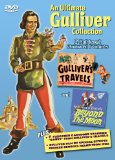Johnathan Swift’s Gulliver’s Travels was never meant to be a children’s tale. It is one of the most corrosive satires in the English language, one that has lost none of its brilliant venom over the passage of centuries. But endless bowdlerizations have given its first two sections (the voyages to Lilliput and Brobdingag) the reputation for being children’s classics. Obviously, references to people being “the most pernicious race of little odious vermin that nature ever suffered to crawl upon the surface of the earth” are usually left out. At any rate, said bowdlerizations inevitably resulted in various anodyne film adaptations. And so, as Jack Black galumphs across the screen to box office disaster, here is a collection of animated takes on Swift’s work.
Gulliver’s Travels: (76 mins.) This 1939 effort is the main attraction here, the second feature-length animated film ever made. It limits itself to Gulliver’s journey to Lilliput, where, in this version, he must bring about the end of a war between Lilliput and Blefuscu so that bland princess and prince of the respective nations can marry. The Fleischer brothers are best remembered for Betty Boop and their excellent Superman cartoons. Gulliver’s Travels, on the other hand, is far from their best work. The animation is fluid, though the backgrounds are lifeless and still, a far cry from what Disney had just done with Snow White. The pace is slack, meandering along through rather tired slapstick. The cartoonish Lilliputians are charming enough, but the more realistic characters are expressionless waxworks, or, in the case of the rotoscoped Gulliver, dip alarmingly toward the uncanny valley. The piece is a historical curiosity, but is no classic. Still, it’s much, much better than…
Gulliver’s Travels Beyond the Moon: (85 mins.) We’re still in the historical curiosity department here (as I suppose, is true with all of the entries on this disc). This bizarre piece is an early anime from 1965, and tells the story of a young boy and his dog who meet up with an aged Gulliver for outlandish travels. The animation is more fluid, in some ways, than what we are used to with today’s anime, and the art style is much closer its American counterpart, but the film is an ordeal to sit through.
Gabby Shorts: (48 mins) Spinning off from the Fleischer film, these seven shorts feature Lilliput’s town crier, Gabby (who sounds like Porky Pig without the stutter). These still manage to be rather leisurely in their pace (we’re not talking Tex Avery here, that’s for sure).
Gulliver’s Travels Among the Lilliputians and the Giants: (4 mins.) This is actually the biggest treat on the disc: Georges Méliès’ 1902 short showcases his special effects artistry (and here is the forced perspective that Peter Jackson would still be making use of a century later). It’s in colour, too, with very frame hand-painted.
Video
Extremely variable, but varying from the mediocre to the dire. Gulliver’s Travels gets by, but the print has plenty of speckling (no restoration here), the colours are murky, and the print has a bit of a pink tint to it now. Furthermore, the cropping around the edges here (as with the other films on the disc) is very noticeable. Beyond the Moon, however, looks horrible. No small part of its unwatchability is the abysmal transfer. The picture is dim, blurry and horribly pixelated, and the print is damaged. Imagine watching YouTube on a big-screen TV. Not a pretty picture, is it. The Gabby shorts, meanwhile, are more damaged than the main feature, and a bit washed out, but won’t make you jab your thumbs into your eyes. It’s our 1902 short that comes off best, with a surprisingly crisp, clear picture. How’s that for irony? The aspect ratio is, in every case, 1.33:1.
Audio
It’s all mono, all the way, of course. And as fare the images, so do the sounds. The mono on Gulliver’s Travels is fine, being quite warm and distortion-free. The same is true for the Gabby cartoons. Beyond the Moon was apparently recorded underwater. On wax cylinders. (Though the sound is still better than the picture.) The piano track added to the Méliès film sounds good.
Special Features
None.
Final Thoughts
There is considerable historical interest here, but the the quality of the transfers and prints has all the earmarks of a public domain cash-in.





